The author, Carlo Vialu, PT, MBA, is co-creator of SeekFreaks. He loves promoting function and participation for children and youth with disabilities, from our assessment to our interventions, via continuing education courses at www.ApplyEBP.com. More about these courses after the article.
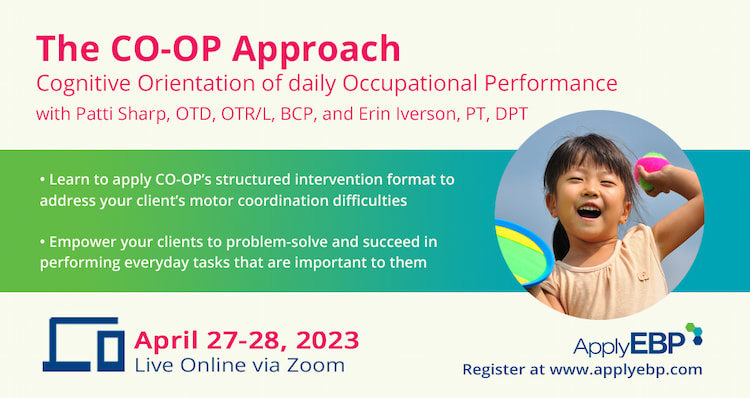
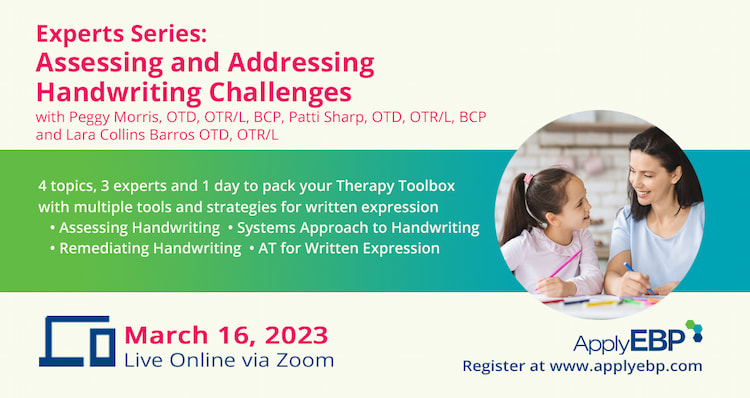

I have this nagging feeling that as a pediatric therapist, I always need to be creative…very creative! I’m not sure where this came from. Perhaps, a professor back in PT school told me so. Or one of my clinical instructors. Maybe it was peer pressure during my pediatric clinical rotation when everybody around me was coming up with the most creative ideas using the most complicated or sometimes the most banal of materials. Maybe it’s all the social media posts about “What exciting thing are you working on with your client this Spring?” or “…this Thanksgiving?…and no turkey hands, please!”
Wherever it came from, it has become a burden. Am I being creative? Am I doing something exciting? Is it appropriately themed for the season?
I started feeling less of a therapist when I am not creative enough…and essentially think of myself as being a boring therapist. The therapist that does not bring toys, the therapist that does the same thing over and over again. Who wants to be boring?!
Soon enough, this can turn into a feeling of insecurity…where I started equating my value as a therapist to my level of creativity (or the lack of).
Olivia and Bear (not their real names)
This feeling crept up when I was working with a 2 year old child, let’s call her Olivia (not her real name to observe confidentiality). She had general developmental delay in all areas, from mobility to communication. While Olivia loved crawling, she hated being upright and taking steps. Surely, she’s thinking “I can get to what I want effectively by crawling, or they carry me around, so why do I have to walk?” Oh yes, she was carried around a lot. I discussed with the family their goals for her…and it was to get her walking, which we all agreed she had the potential to do.
I put on my motor learning framework lens, and knew Olivia needed to walk by any means. Lots of cruising, pushing “walker-like” toys, and not so much of being held to walk. On carpet, and on linoleum, which they had in their home. The family agreed that she needed to be carried less, and to create lots of opportunities for walking. Her leg muscles appear weak, but I was sure they will get better the more she walked.
On my first 2 sessions, I was greeted with a lot of crying as I attempted to get her upright and taking steps. I used every toy her family presented to me…a push toy, a ride-on bus, a toy car, etc. On day 3, I was resolved to not be cried on the whole time. I looked around and found 20 or so stuffed toys on her bed. I pointed at one of them and said “Bear is thirsty..let’s take him to the kitchen to drink water.” (Bear is not the real toy’s name either 🙂 )
Breakthrough! Olivia reached for Bear, I secured Bear to her push toy “walker”, and off we went! She was walking by pushing her “walker” to the kitchen so Bear can drink. We came back for the next toy, and the next, and the next until she tired from walking and needed a break.
Fast forward 3 months later…her preferred game is still bringing her toys to the kitchen for a drink. Not pushing balls across a table, playing with her kitchen, walking over obstacle “toys” or trying out other toys, games or activities. I said ok, as long as her walking is getting better.
Fast forward 8 months later when she no longer needed the toy “walker” to walk: her favorite thing to do? Still bringing Bear to the kitchen. OMG! Did my breakthrough turned me into a “boring” therapist? Olivia humored me by completing other games and activities, but this was her favorite.
Pause…Breath…Reflect
So I had to pause to take a breather…and do some soul-searching. Why do I feel this way from time to time? Why does being not-too-creative make me feel like a boring therapist? Or worse, a less valuable therapist?…Or am I just being too hard on myself?
I decided the first question to answer is “Why do I always feel the need to be creative?” If I’m being honest, here are a few reasons I came up with:
- You do not learn everything from OT, PT or SLP school, especially working with children. To be an effective therapist, I have to be creative to apply what I learned (and continue to learn from continuing education and research) when working with children!
- Kids get bored easily, don’t they? So, creating new activities and games means my pediatric client will always be engaged…they will not be bored and run away from me.
- I pride myself for being able to come up with interventions that are so creative, they can only come from a top-notch therapist like myself!
- Coming up with creatively new activities is a sign that I am an experienced therapist…with experience come more tools for the practice.
- When others are watching me (family, teacher, colleague, etc.), am I being viewed as a therapist that does something special….something novel…something out of the ordinary? Or are they judging the repetitive activities.
- That little voice in my head that says “You are the co-creator of SeekFreaks! You better be amazing!”
I laughed as I created this list. Because they are all true…at least in my head. The next step is to think about each of these and validate whether they are true in real life.
And guess what I came up with…In my role as a therapist, only the first one matters! I need creativity to be able to translate what I learned from school and what I am learning from current evidence and individualize the application to my pediatric client. And if my client is engaged, i.e., not bored, then I have to get over thinking I am “boring.”
Debunking The Reasons Above
What about the other points above? I debunked them one at a time too:
#2: Kids do get bored easily…if what they are doing is not meaningful to them. Otherwise, they are engaged and love repetition of something that they like or is meaningful to them.
- Every parent who has complained that they have watched “Winnie the Pooh!” a million times can attest to this. This is supported by research were parents reported that their children 2 to 4 years old “almost always” watched videos repeatedly (Mares, 1998).
- This need for repetition was exploited effectively by the TV show Blue’s Clues which showed the same episode every single day. Anderson et al (2000), found that with this format, preschool children where initially “relatively quiet and inattentive. As they mastered the content they became increasingly vocal and interactive.” Better yet, “the program had a positive impact on cognitive development.” Wow! Watching the same episode with Steve and Blue (and Magenta) would be really boring for me…but not for many preschoolers!
- Crawley et al (1999) concluded that “Episode repetition is an effective strategy for enhancing learning and program involvement for a preschool audience.” I’ll let this simmer and savor it for a few minutes…Why? Because that’s what my motor learning framework lens tells me…repetition is also essential for motor learning and neural plasticity to occur! (Kleim & Jones, 2008) Lots of opportunity for practice and high repetitions.
- This begs the question, “Who is bored then?” – is the child bored or are you? Or may be you are not even bored, but you think others may see what you are doing as boring?
- In the case of Olivia, bringing her stuffed toys to the kitchen for a drink is meaningful – she likes taking care of them. She is not bored by the activity! So she repeated the same activity over and over again. I added some challenges. Pushing other toys, such as a toy shopping cart, a toy baby stroller, or nothing at all. Carrying 2 stuffed toys…heavier ones, etc.
(I just posed here an argument for preschoolers, but we know the same is true for older kids and adults, like you and me…we repeat activities that we like!)
#3 and #4 are just my ego toying with me, and I need to get over them.
#5 Yes, from an adult’s point of view, repetitive activities may look boring…and the family may think that. But did they?
- Let’s go back to Olivia. A week after my breakthrough, her mother is complaining (half-jokingly) that she is exhausted. Olivia likes playing the same game with her – bringing Bear to the kitchen for water over and over again!
- Wow! Carryover! Initiated by Olivia, no less.
- One member of the family or another typically joined me during my sessions. They were helpers and motivators. They saw all the repetition. By keeping the activity simple, it made carryover easy.
- If I had been too creative and made the activity too complicated, or used a toy that I bring only for my therapy session, would the carryover at this high level still occur?
- The more I think of it…instead of being “boring,” I think they viewed my intervention, and therefore me, as effective!
#6 I had to replace it with a voice that says “Get over yourself!” SeekFreaks was created to promote evidence-based practice, not to promote creativity for creativity’s sake. Here are other better replacements for that voice:
- Are you applying evidence into your practice?
- If not, is there an intervention that is supported by evidence that you can apply?
- Is your intervention effective? Do you have data to show this?
- With Olivia, I used my motor learning principles that are evidence-based. And yes, it was effective, and I had data to show that.
Flowcharts? Yeah!!!
I’m glad I did this soul-searching. I can celebrate (what superficially may appear as) the “boring” therapist in me! If anything, I resisted the “creative urge” from getting in the way of being effective.
In case I am thinking of myself as bored again, I created a short flowchart to help me through the process of validating my feeling and my effectiveness as a therapist and know the actions I have to do along the way. See the infographic “Is it OK to be a Boring Therapist?”, and perhaps you may find it useful too.
Or wondering if your creativity is paying off? Or are you being creative for creativity’s sake, and it’s getting in the way of your effectiveness? See the infographic below, “Is it OK to Be a Creative Therapist?”
Of course, these are simplified charts…there are other things to consider, such as the cost of your intervention (i.e., are you spending too much in time, materials and effort, when there’s an alternative that cost less in these resources), the appropriateness to the environment (whether it be home, school or out in the community), the carryover effect (as I described above), etc. Think about those too as you answer these questions.
In the meantime, as my New Year’s Resolution: I will take more time to celebrate the “boring” therapist in me!
I hope you will celebrate yourself too, even when you are thinking “am I a boring therapist?
Catch the author Carlo Vialu, PT, MBA in the following continuing education courses:
References
Anderson, D. R., Bryant, J., Wilder, A., Santomero, A., Williams, M., & Crawley, A. M. (2000). Researching Blue’s Clues: Viewing behavior and impact. Media psychology, 2(2), 179-194.
Crawley, A. M., Anderson, D. R., Wilder, A., Williams, M., & Santomero, A. (1999). Effects of repeated exposures to a single episode of the television program Blue’s Clues on the viewing behaviors and comprehension of preschool children. Journal of educational psychology, 91(4), 630.
Kleim, J. A., & Jones, T. A. (2008). Principles of experience-dependent neural plasticity: implications for rehabilitation after brain damage. Journal of speech, language, and hearing research, 51(1), S225-S239.
Mares, M. L. (1998). Children’s use of VCRs. The Annals of the American Academy of Political and Social Science, 557(1), 120-131.
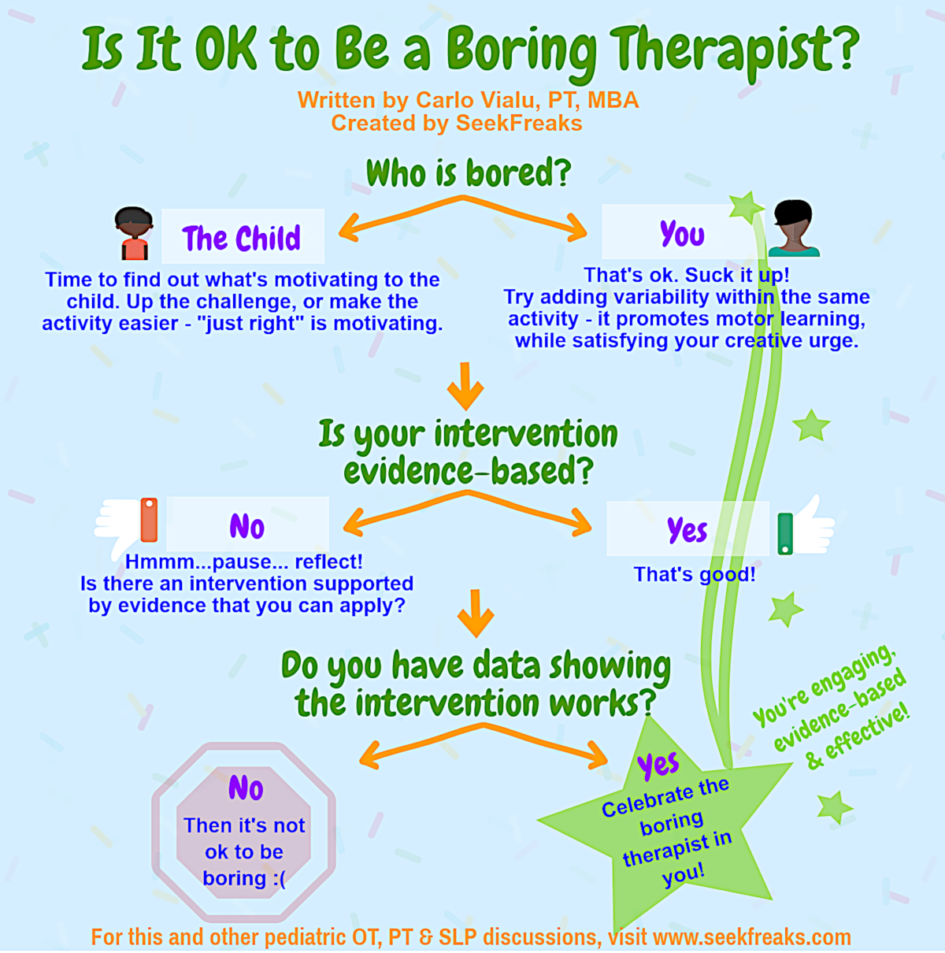
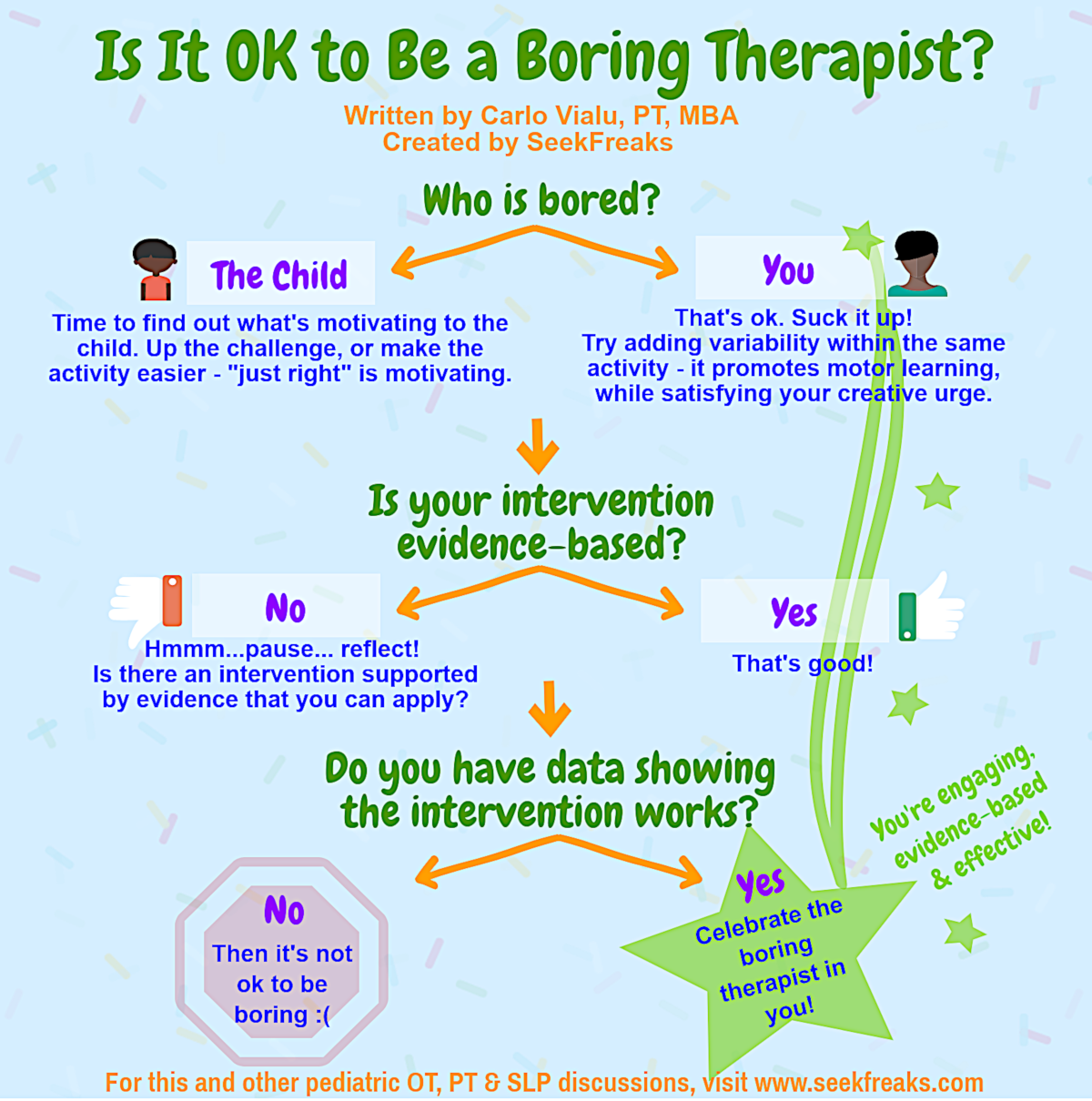
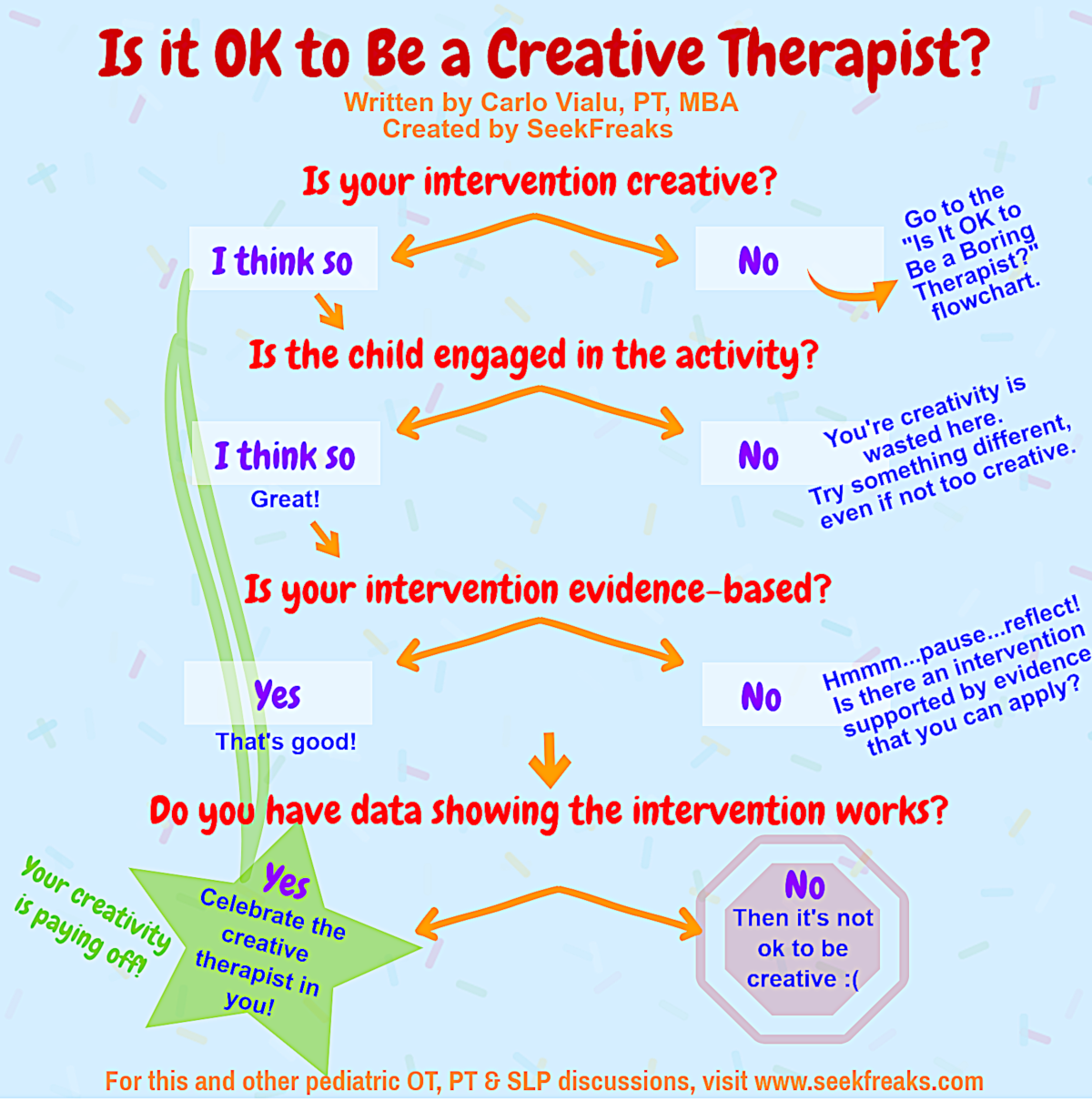
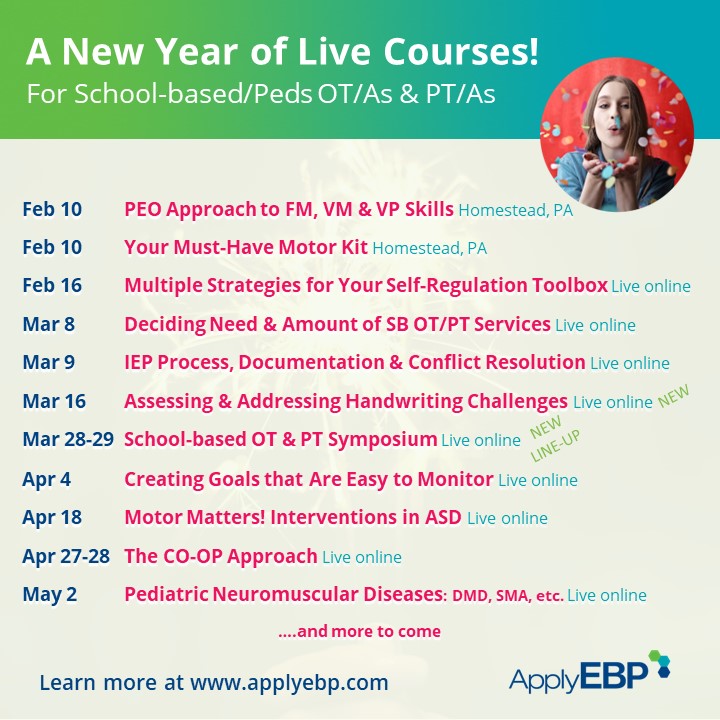
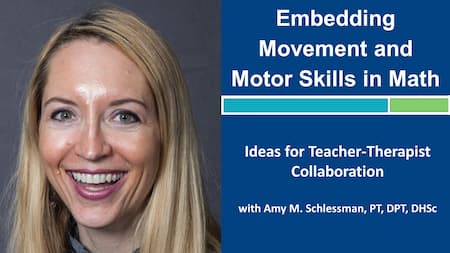
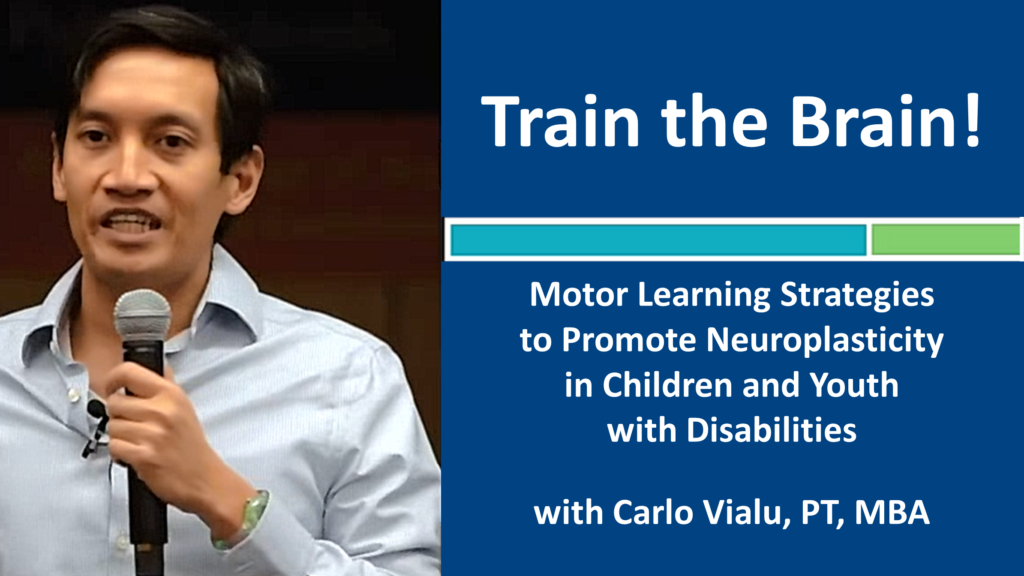











November 6, 2023 at 9:58 pm
etr4ge